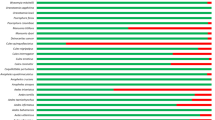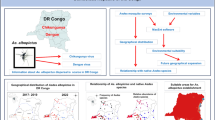Abstract
The invasive Asian tiger mosquito, Aedes albopictus, has been established on the French overseas island of Mayotte in the Indian Ocean since 2007. Despite the presence of a resident population of Aedes aegypti, Ae. albopictus has expanded its presence in urban areas, in contrast to the pattern of invasion by this mosquito elsewhere in the world. We undertook a comparative study of the distribution and abundance of Ae. albopictus and Ae. aegypti populations between 2007 and 2010 in different types of urban landscapes to document the invasion process. Urban and suburban areas at five localities on Mayotte were selected and ten houses with mosquito-infested larval habitats on the property were located in each area. To calculate variables that might explain mosquito infestation, the areas around the houses selected were overlaid on maps with grid cells (each 25 × 25 m) and the areas inside grid cells were analyzed to define landscape characteristics (percentage of built on land and human density) that might be predictive of Ae. albopictus presence and abundance. The proportion of sites occupied by only Ae. albopictus and the relative abundance of this species relative to total Aedes larvae and pupae significantly increased between 2007 and 2010, in both urban and in rural areas. In the 2010 survey, the number of larval habitats occupied by Ae. aegypti in the sampled area decreased sharply compared to 2007. The proportion of land with paved or hard surfaces (roads, buildings, hereafter “built-up area”), the increase of urbanized areas between 2003 and 2008, and the density of human residents were all correlated with higher relative abundance of Ae. albopictus. The urban areas of Mayotte have significant amounts of vegetation even in the more densely populated areas, and this factor may have facilitated the invasion of Ae. albopictus by providing abundant adult resting sites. These findings are relevant for vector control strategies and forecasting the success of invasions of Ae. albopictus in urban areas in other countries.




Similar content being viewed by others
References
Bagny L, Delatte H, Elissa N, Quilici S, Fontenille D (2009a) Aedes (Diptera: Culicidae) vectors of arboviruses in Mayotte (Indian Ocean): distribution area and larval habitats. J Med Entomol 46:198–207
Bagny L, Delatte H, Quilici S, Fontenille D (2009b) Progressive decrease in Aedes aegypti distribution in Reunion Island since the 1900s. J Med Entomol 46:1541–1545
Barker CM, Paulson SL, Cantrell S, Davis BS (2003) Habitat preferences and phenology of Ochlerotatus triseriatus and Aedes albopictus (Diptera : Culicidae) in southwestern Virginia. J Med Entomol 40:403–410
Benedict MQ, Levine RS, Hawley WA, Lounibos LP (2007) Spread of the tiger: global risk of invasion by the mosquito Aedes albopictus. Vector Borne Zoonotic Dis 7:76–85
Braks MAH, Honorio NA, Lourenco-De-Oliveira R, Juliano SA, Lounibos LP (2003) Convergent habitat segregation of Aedes aegypti and Aedes albopictus (Diptera : Culicidae) in southeastern Brazil and Florida. J Med Entomol 40:785–794
Carbajo AE, Curto SI, Schweigmann NJ (2006) Spatial distribution pattern of oviposition in the mosquito Aedes aegypti in relation to urbanization in Buenos Aires: southern fringe bionomics of an introduced vector. Med Vet Entomol 20:209–218
Carrieri M, Bacchi M, Bellini R, Maini S (2003) On the competition occuring between Aedes albopictus and Culex pipiens (Diptera: Culicidae) in Italy. Environ Entomol 32:1313–1321
Chan YC, Chan KL, Ho BC (1971) Aedes aegypti (L.) and Aedes albopictus (Skuse) in Singapore-City. 1. Distribution and density. Bull World Health Org 44:617–627
Christophers SR (1960) Aedes aegypti (L.) the yellow fever mosquito: its life history, bionomics and structure. Cambridge University Press, Cambridge
Cox J, Grillet ME, Ramos OM, Amador M, Barrera R (2007) Habitat segregation of dengue vectors along an urban environmental gradient. Am J Trop Med Hyg 76:820–826
Delatte H, Bagny Beilhe L, Brengue C, Bouetard A, Paupy C, Fontenille D (2011) The invaders: phylogeography of dengue and chikungunya viruses vectors, Aedes albopictus, Aedes aegypti and Aedes mascarensis, on the South West islands of the Indian Ocean. Infect Genet Evol 11(7):1769–1781
Ellis AM (2008) Linking movement and oviposition behaviour to spatial population distribution in the tree hole mosquito Ochlerotatus triseriatus. J Anim Ecol 77:156–166
Gilotra SK, Rozeboom LE, Bhattacharya NC (1967) Observations on possible competitive displacement between populations of Aedes aegypti L. and Aedes albopictus Skuse in Calcutta. Bull WHO 37:437–446
Gratz NG (2004) Critical review of the vector status of Aedes albopictus. Med Vet Entomol 18:215–227
Hawley AH (1988) The biology of Aedes albopictus. J Am Mosq Contr Assoc 4:1–40
Higa Y, Thi Yen N, Kawada H, Hai Son T, Thuy Hoa N, Takagi M (2010) Geographic distribution of Aedes aegypti and Aedes albopictus collected from used tires in Vietnam. Am Mosq Contr Assoc 26:1–9
Juliano SA (2009) Species interactions among larval mosquitoes: context dependence across habitat gradients. Annu Rev Entomol 54:37–56
Juliano SA, Lounibos LP (2005) Ecology of invasive mosquitoes: effects on resident species and on human health. Ecol Lett 8:558–574
Kamgang B, Happi JY, Boisier P, Njiokou F, Herve JP, Simard F, Paupy C (2010) Geographic and ecological distribution of the dengue and chikungunya virus vectors Aedes aegypti and Aedes albopictus in three major Cameroonian towns. Med Vet Entomol 24:132–141
Lockwood JL, Hoopes M, Marchetti M (2008) Invasion ecology. Wiley Blackwell, New York
Lounibos LP (2007) Competitive displacement and reduction. J Am Mosq Contr Assoc 23:276–282
Maciel-De-Freitas R, Brocki R, Goncalves JM, Codeco CT, Lourenco-De-Oliveira R (2006) Movement of dengue vectors between the human modified environment and an urban forest in Rio de Janeiro. J Med Entomol 43:1112–1120
Paupy C, Delatte H, Bagny L, Corbel V, Fontenille D (2009) Aedes albopictus, an arbovirus vector: from the darkness to the light. Microb Infect 11:1177–1185
Swanson J, Lancaster M, Anderson J, Crandell M, Haramis L, Grimstad P, Kitron U (2000) Overwintering and establishment of Aedes albopictus (Diptera : Culicidae) in an urban La Crosse virus enzootic site in Illinois. J Med Entomol 37:454–460
Tabachnick WJ (1991) Evolutionary genetics and arthropod-borne disease. The yellow fever mosquito. Am Entomol 37:14–24
Taglioni F, Dehecq J-S (2009) L’environnement socio-spatial comme facteur d’émergence des maladies infectieuses- Le chikungunya dans l’océan Indien. EchoGéo 9 (Open Access). URL: http://echogeo.revues.org/11168
R Development Core Team (2011) R: a language and environment for statistical computing. R Foundation for Statistical Computing, Vienna, Austria. ISBN 3-900051-07-0. URL http://www.R-project.org/
Tripet F, Lounibos LP, Robbins D, Moran J, Nishimura N, Blosser EM (2011) Competitive reduction by satyrization? Evidence for interspecific mating in nature and asymmetric reproductive competition between invasive mosquito vectors. J Am Trop Med Hyg 85:265–270
Tsuda Y, Suwonkerd W, Chawprom S, Prajakwong S, Takagi M (2006) Different spatial distribution of Aedes aegypti and Aedes albopictus along an urban-rural gradient and the relating environmental factors examined in three villages in northern Thailand. J Am Mosq Contr Assoc 22:222–228
Vezzani D, Velazquez S, Soto S, Schweigmann N (2001) Environmental characteristics of the cemeteries of Buenos Aires City (Argentina) and infestation levels of Aedes aegypti (Diptera: Culicidae). Mem Inst Oswaldo Cruz 96:467–471
Acknowledgments
The authors thank J. Thiriat, B. Zumbo and the technicians of the regional vector control laboratory of Mayotte (ARS-OI) for invaluable help with the field and the laboratory work and Mr Cieslak from “Préfecture de Mayotte” for the GIS data. We also thank anonymous reviewers and D. Simberloff for useful comments on the manuscript. We are grateful to VanDriesche scientific editing for the English improvement. This work was founded in part by CIRAD, IRD, the “Conseil Régional de la Réunion”, the “EU”, and “Agence Régional de Santé Océan Indien” (ARS OI).
Author information
Authors and Affiliations
Corresponding author
Rights and permissions
About this article
Cite this article
Bagny Beilhe, L., Arnoux, S., Delatte, H. et al. Spread of invasive Aedes albopictus and decline of resident Aedes aegypti in urban areas of Mayotte 2007–2010. Biol Invasions 14, 1623–1633 (2012). https://doi.org/10.1007/s10530-012-0177-1
Received:
Accepted:
Published:
Issue Date:
DOI: https://doi.org/10.1007/s10530-012-0177-1




